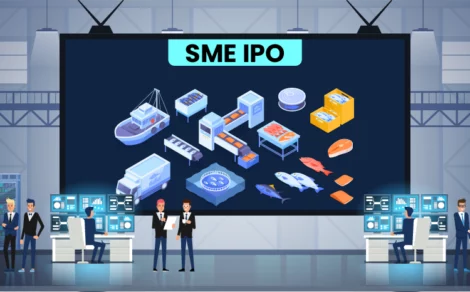Ever heard the buzz around a new IPO and wondered, “How do they even decide the price of a share?” Why does one company launch its IPO at ₹95 and another at ₹950? It’s not random. There’s a strategy. A method. And often, a bit of psychology.
In this blog, we’ll break down how IPO pricing works, no finance degree needed.
Let’s go beyond the hype and understand what goes into that price tag before a stock even hits the market.
Why IPO Pricing Even Matters?
When a company goes public, it’s not just about raising money, it’s also about how much. Price too low, and the company leaves money on the table. Price too high, and the stock might crash on listing day. Neither is ideal.
For investors, IPO pricing is the first clue to decide: “Should I apply for this IPO?” So, understanding the mechanics behind it can actually save you from making costly mistakes.
The Fundamentals of IPO Pricing
IPO pricing refers to the process of determining the price at which shares of a company will be offered to the public for the first time. This price isn’t pulled out of a hat. It’s calculated based on multiple factors like company performance, demand, market trends, and what similar companies are valued at.
There are two main ways this price can be set:
- Fixed Price Method
- Book Building Method
We’ll dig into both in just a bit.
How IPO Pricing Mechanisms Work: A Detailed Look
Imagine you’re selling your used car. You’d probably ask around, check similar listings, see what dealers are offering, and maybe even test how much people are willing to pay. IPO pricing works similarly but with a bit more structure.
The company, along with its lead managers (investment bankers), works through various numbers and market conditions to determine what investors might be willing to pay. Then, based on the method chosen, they either fix a price or create a price band.
Let’s go a little deeper.
Approaches to IPO Pricing
-
Fixed Price Issue
This is the old-school way.
In a fixed price issue, the company decides on a specific price beforehand and announces it in the offer document. Let’s say a company sets its IPO price at ₹100. If you want to apply, that’s the price you’ll pay per share.
Pros:
- Simple to understand
- Transparent upfront pricing
Cons:
- No flexibility
- No price discovery- demand is guessed
Example: If 10 people want shares, but the company only expected 5, they may have underpriced the IPO.
-
Book Building Method
This is more common today, especially in big IPOs.
In this method, a price band is declared (like ₹95 to ₹105). Investors bid within this range. Based on all the bids received, the company discovers the final issue price, usually the price at which they can sell the desired number of shares.
This is called price discovery.
Let’s say the demand is highest at ₹102. That becomes the issue price.
Pros:
- Market-driven pricing
- More fair and efficient
Cons:
- Can be a bit confusing for new investors
- Not 100% predictable
Example: Companies like Zomato, Nykaa, and LIC used this method to price their IPOs.
What Factors Influence IPO Pricing?
So, what actually goes into deciding that magic number? Here are the key factors:
- Company Fundamentals: This includes revenue, profits, assets, debts, and cash flows. A profitable and growing company can command a higher price.
- Peer Comparison: They look at how similar companies (competitors) are valued. If peers are trading at high multiples, the IPO price may reflect that optimism.
- Market Conditions: Bull market? You can charge more. Bear market? Better play it safe.
- Investor Appetite: If the grey market premium (GMP) is high and investor interest is strong, the company might price the IPO at the upper end of the band.
- Use of Funds: If the money raised is going toward expansion or innovation, it might justify a higher valuation than, say, just paying off old loans.
Quick Peek: IPO Pricing in Action
| Factor | Impact on IPO Price |
|---|---|
| High Profit Margins | Higher valuation |
| Strong Brand Value | Investors may accept premium pricing |
| Negative Cash Flow | Likely to impact pricing negatively |
| Market Volatility | May lead to conservative pricing |
| Huge Retail Demand | Increases the chances of higher pricing |
Why Does This Matter for Investors?
You don’t want to overpay.
Let’s say a company prices its IPO at ₹500. On listing day, it opens at ₹470. You’ve lost ₹30 per share right away. Not a great start.
But if you understood how the pricing worked, checked financials, and looked at peer comparison, you might have seen it coming.
So, understanding IPO pricing isn’t just technical mumbo-jumbo. It’s your defence mechanism against making blind bets.
Top Upcoming IPOs to Watch (23rd–27th June 2025)
- Kalpataru Ltd IPO
- HDB Financial Services Ltd IPO
- Globe Civil Projects Ltd IPO
- Ellenbarrie Industrial Gases Ltd IPO
- Suntech Infra Solutions Ltd IPO
Conclusion: Should You Trust the IPO Price?
Here’s the truth: not always.
The IPO price is what the company hopes the market will pay. Sometimes they get it right. Other times, they overshoot. Or underprice it to create hype.
Your job as an investor is to look beyond the surface.
- Check the valuation multiples
- Read the red herring prospectus (even just key sections)
- Look at market mood
- Don’t rely only on grey market buzz
If something feels overpriced, it probably is.
Remember, you’re not just buying a stocks, you’re buying into a company’s story. Make sure it’s worth it.
Ready to invest in an IPO? Explore all mainboard IPOs with Torus Digital’s trading account.


